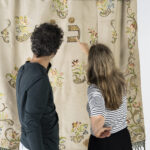«Wimples are great for telling stories»
Seven questions to Dinah Ehrenfreund
The Jewish Museum of Switzerland preserves hundreds of wimples from the 17th to the 20th centuries. In «Birth Culture. Jewish Artifacts from Rural Switzerland and Environs» (Schwabe 2022), the Museum’s latest publication, curator Dinah Ehrenfreund explains what Torah binders can tell us about changing times.
Naomi Lubrich: Dinah, you are an expert on wimples. What are they?
Dinah Ehrenfreund: Wimples are binders that wrap the Torah scroll and protect the parchment. Once bound, the Torah scroll is covered with a mantle and adorned with silver jewelry. Torah wimples are widespread in synagogues and prayer rooms. In German-speaking Ashkenaz, a special tradition developed, which was to inscribe the binder with a boy’s name, birthday and the blessing from the circumcision liturgy: «As he was introduced into the covenant, so may he be led to the Torah, to marriage, and to good deeds. Amen. Sela.» The oldest wimples date back to the 16th century. Intriguingly, the cloth band is made from the boy’s circumcision diaper. The rectangular cloth is cut into four strips, sewn together lengthwise, inscribed and embroidered or painted – and later donated to the synagogue.
NL: Who could afford to donate such a wimple to their community?
DE: While a small number of wealthy families donated Torah curtains or silver utensils, a great number of families in the Swiss rural communities contributed a wimple when a son was born. In the 19th century, wimples were not expensive gifts. They were a personal donation to the community and a way for each boy to be remembered.
NL: Who has studied the Swiss wimples?
DE: Florence Guggenheim-Grünberg (1898–1989) was the first scholar after 1945 to systematically study an inventory of synagogue wimples. She was a distinguished expert on Jewish folklore in Switzerland at that time. From today’s perspective, her view of Jewish folklore was nostalgic, seeing wimple-making as a thing of the past. She barely noted that wimples were still made in her era, albeit less frequently. Later, Peter Stein conducted a study of wimple-making in the 20th century, which showed that there was and still is a vibrant wimple culture.
NL: Wimples were made for boys – do they also document the lives of women?
DE: Not really. Men performed all acts of worship in orthodox Judaism, and pre-modern documents almost exclusively record men as heads of families. Wimples are material testimonies of a male-dominated society. Although women gave birth to children and helped make the wimples, their names were not recorded.
NL: Many wimples are illustrated. What are the motifs?
DE: The Torah scroll is the most common illustration. It illustrates the purpose, both practical and ideal. Another common symbol is the chuppah, the wedding canopy. The 18th century wimples refer to zodiac signs, in words and images. Another image is the serpentine eight on its side, which symbolizes eternity. It appears on wimples from Alsace. You can also find the serpentine eight on Christian baptismal cards. It stands for the wish for a long life.
NL: Have you detected any Swiss particularity in the Jewish Museum’s collection?
DE: It depends on the century. Particularly the 17th century wimples from Lengnau are similar to Alsatian and German wimples. But there is one distinguishing feature from the mid-19th century which spans a wide area in Switzerland: On these wimples, the letters alternate between a Gothic script and a semi-cursive modern script. From 1865 onwards, a particularly noteworthy iconographic feature appears on this «Swiss type.» Above the Hebrew date of birth, a band of script provides the name, date and place of birth, or hometown, in Latin letters. Switzerland fortunately kept and still keeps important historical sources in existing communities and archives.
NL: Wimple-making today is becoming a lost art.
DE: True. For individuals and for the community, wimple-making used to be much more important. Ideally, a synagogue would keep the wimples of all the men in a congregation over a long period of time as evidence of its size and importance. The more wimples a community had and the older they were, the more significant the community was. When the state began documenting the births, the wimples lost in significance, around 1900. Today, some families still make wimples. For others, it has little significance and for still others, they are completely unknown. In any case, wimples are good for telling interesting stories!
NL: Thank you very much, Dinah.
verfasst am 14.02.2023



